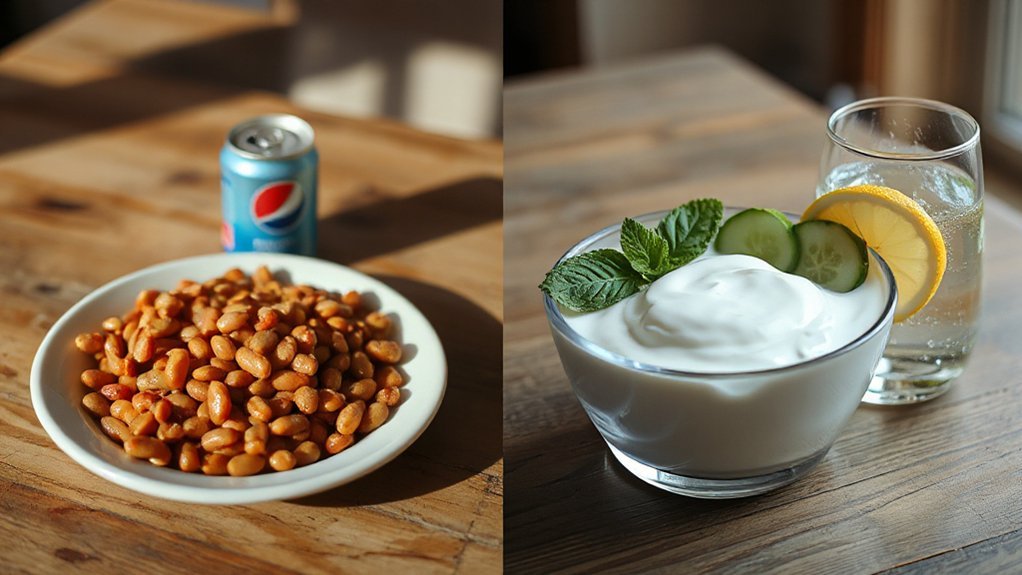Bloating can come from swallowed air, certain foods, slow gut motility, or underlying conditions, so start by noticing when it happens and what you eat. You’ll want practical steps backed by evidence—diet changes (low-FODMAP options), slower eating, hydration, movement, and simple tests at home—to reduce gas and discomfort. Keep going to learn specific foods, habits, quick relief techniques, and when to seek medical evaluation.
Key Takeaways
- Eat slowly, chew thoroughly, and avoid carbonated drinks to reduce swallowed air and early gas buildup.
- Limit high-FODMAP and sugar-alcohol foods (onions, beans, apples, sorbitol) that commonly ferment and cause bloating.
- Stay hydrated, eat smaller frequent meals, and include soluble fiber to normalize stool and reduce distension.
- Move after meals (walk, gentle yoga) and practice diaphragmatic breathing to improve intestinal motility and relieve gas.
- Track symptoms, medications, and diet for two weeks and see a clinician if bloating is severe, persistent, or accompanied by alarm signs.
Common Causes of Bloating

Although occasional bloating can come from overeating or swallowing air, persistent or severe bloating usually reflects identifiable causes you can address. You should first evaluate functional disorders like irritable bowel syndrome and small intestinal bacterial overgrowth, both linked to gas production and altered motility. Structural issues—obstruction, adhesions, or ascites—require prompt assessment. Malabsorption (lactose or fructose intolerance, celiac disease) often produces chronic symptoms. Consider medication history: certain medications, including opioids, anticholinergics, and some antidiabetics, slow transit or alter flora, worsening bloating. In women, hormonal changes across the menstrual cycle or with contraceptives can increase fluid retention and gut sensitivity. Use targeted testing and medication review to differentiate causes and guide specific, evidence-based interventions.
Foods That Trigger or Relieve Bloating

Now that you’ve considered medical and functional causes, look closely at how specific foods alter symptoms—dietary choices often make the biggest day-to-day difference for bloating. Identify common triggers: high-FODMAP items (onions, garlic, beans, certain fruits), carbonated drinks, and sugar alcohols often increase gas and distension. Conversely, some foods reduce symptoms: low-FODMAP vegetables, lean proteins, and soluble-fiber sources can help when introduced gradually. Incorporate probiotic foods like yogurt or kefir if tolerated; trials show selected strains can lower bloating in some patients. Monitor portion sizes and fiber type rather than eliminating fiber entirely. Keep attention on hydration levels—adequate fluids support transit and fiber function. Track responses systematically and consult your clinician for personalized testing or therapeutic guidance.
Practical Eating Habits to Reduce Gas and Discomfort

Eat slowly and chew thoroughly to reduce swallowed air and improve digestion, which clinical studies link to less gas and bloating. You should also limit high-fermentable foods (like beans, certain vegetables, and carbonated drinks) that commonly produce excess gas. Combining mindful eating with targeted food choices gives you practical, evidence-based control over post‑meal discomfort.
Eat Slowly, Chew Thoroughly
When you slow your pace and chew each bite thoroughly, you reduce swallowed air and give digestive enzymes more time to start breaking down food, which lowers the risk of gas and bloating. You should practice mindful eating: sit down, remove distractions, and focus on taste and texture so you naturally slow intake. Aim for 20–30 chews per mouthful or until the food feels smooth; that improves mechanical breakdown and exposes more surface area to saliva and gastric enzymes, aiding digestive health. Pause between bites, put utensils down, and sip water rather than gulping. Clinically, these habits lower aerophagia and may reduce postprandial distension. Track symptoms for two weeks to confirm benefit and adjust pace as needed.
Limit Gas-Producing Foods
Although some high-fiber and fermentable foods are healthy, you can cut bloating by identifying and moderating specific gas-producing items in your diet. You’ll want to balance fiber intake to avoid sudden increases that feed colonic bacteria and produce gas. Also practice carbonation reduction—swap fizzy drinks for still water to limit swallowed air and intestinal gas. Clinically, trial elimination for 1–2 weeks to see symptom change, then reintroduce foods systematically.
- Legumes: soak, rinse, and start with small portions; consider enzyme supplements if tolerated.
- Cruciferous vegetables: cook thoroughly and monitor portion size to reduce fermentable substrates.
- Dairy and sugar alcohols: test lactose tolerance and limit sorbitol, mannitol, xylitol.
Track symptoms, adjust portions, and consult a clinician if bloating persists.
Lifestyle Changes That Help Prevent Bloating
Because small daily habits affect gut function, adjusting your lifestyle can meaningfully reduce bloating; practical, evidence-based changes—like increasing physical activity, improving sleep quality, managing stress, and modifying meal timing—target the physiological drivers of gas retention and slow transit. You should adopt regular hydration habits—consistent, moderate fluid intake supports digestion and stool consistency without overfilling the stomach. Aim for 30 minutes of moderate exercise most days to stimulate intestinal motility. Prioritize 7–9 hours of consistent sleep; circadian disruption impairs gut motility and microbiota balance. Use stress management techniques such as diaphragmatic breathing, brief mindfulness sessions, or cognitive strategies to reduce visceral hypersensitivity. Time your meals, eat slowly, and avoid late heavy dinners to minimize overnight bloating. Track changes and adjust based on symptom response.
When Bloating Signals a Medical Issue
If your bloating is new, severe, persistent, or comes with weight loss, blood in stool, fever, or vomiting, see a clinician promptly because these are red flags that suggest an underlying condition. Your doctor will take a focused history and exam and may order tests such as blood work, stool tests, imaging, or referral for endoscopy to identify causes like infection, inflammatory bowel disease, or obstruction. Don’t wait to report worrying symptoms—early evaluation guides appropriate treatment and prevents complications.
When to See Doctor
When should you see a doctor about bloating? You should seek evaluation if bloating symptoms are new, persistent, or changing despite basic self-care. Timely assessment helps diagnose treatable digestive disorders and prevents complications.
- Sudden severe bloating or abdominal pain that limits activity — seek prompt medical review.
- Persistent bloating with weight loss, blood in stool, vomiting, or fever — these suggest a systemic or structural problem.
- Recurrent bloating that disrupts daily life despite dietary changes and OTC remedies — request specialist referral and targeted testing.
Bring a concise symptom history, medication list, and dietary log. Your clinician will correlate symptoms with exam findings and decide on appropriate investigations or empiric therapy.
Red Flags and Tests
Although bloating is usually benign, certain features should prompt urgent evaluation because they raise the likelihood of a serious underlying condition. If you have severe abdominal pain, unintentional weight loss, persistent vomiting, gastrointestinal bleeding, fever, new-onset symptoms in older age, or progressive abdominal distension, seek prompt medical review. Document your bloating symptoms (onset, pattern, relation to meals, bowel habit changes) to guide clinicians. Initial evaluation includes focused history, physical exam, basic labs (CBC, metabolic panel, inflammatory markers) and stool studies when indicated. Imaging—abdominal X-ray, ultrasound, or CT—helps detect obstruction, masses, or ascites. Endoscopic evaluation (upper endoscopy or colonoscopy) and breath tests for bacterial overgrowth or lactose intolerance are targeted diagnostic tests. Early referral prevents delays in care.
Quick Remedies to Ease Bloating Fast
Because bloating often results from gas, slowed motility, or fluid retention, you can use targeted, fast-acting steps to ease symptoms within minutes to a few hours. Start by sipping herbal teas (peppermint or ginger) to relax smooth muscle and reduce gas; evidence shows modest benefit for postprandial bloating. Apply warm compresses to the abdomen to increase local blood flow and relieve cramping. Walk briskly for 10–20 minutes to stimulate gut motility and accelerate gas transit.
- Try peppermint or ginger herbal teas and avoid carbonated drinks.
- Use a warm compress for 10–15 minutes plus gentle abdominal massage clockwise.
- Walk, do gentle yoga twists, or use over-the-counter simethicone per label if gas persists.
Seek care if symptoms are severe or recurrent.
Conclusion
You can reduce bloating by slowing down, chewing thoroughly, and avoiding carbonated drinks and known high‑FODMAP triggers; focus on lean proteins, low‑FODMAP vegetables, adequate hydration, and regular moderate exercise to promote motility. Track symptoms and try gentle abdominal massage to identify and relieve patterns. If bloating persists, worsens, or comes with alarming signs (weight loss, GI bleeding, severe pain), seek medical evaluation for targeted diagnostics and management based on evidence.